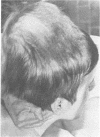Abstract
Two cases of `spontaneous cerebral ventriculostium' are reported. In one case the diagnosis was made during life, and the hydrocephalus was not relieved by the ostium. The unique feature of the other has been the presence of a large defect in the skull bones, posteriorly, which has been a `nature's help' towards maintaining the hydrocephalus stationary, after an initial period of progression.
Full text
PDF





Images in this article
Selected References
These references are in PubMed. This may not be the complete list of references from this article.
- LESLIE E. V., ALKER G. J., Jr SPONTANEOUS VENTRICULOSTOMY. Radiology. 1964 Oct;83:683–686. doi: 10.1148/83.4.683. [DOI] [PubMed] [Google Scholar]
- Lavender J. P., Du Boulay G. H. Aqueduct stenosis and cystic expansion of the suprapineal recess. Clin Radiol. 1965 Oct;16(4):330–333. doi: 10.1016/s0009-9260(65)80074-5. [DOI] [PubMed] [Google Scholar]
- Liss L., Mervis L. Spontaneous ventriculostomy through lamina terminalis with arrest of hydrocephalus. A case report. J Neurosurg. 1965 Aug;23(2):211–213. doi: 10.3171/jns.1965.23.2.0211. [DOI] [PubMed] [Google Scholar]
- SCHEDA V., CSANADI L. [Rupture of the cerebral ventricle associated with hydrocephalus occlusus]. Ideggyogy Sz. 1963 May;16:152–158. [PubMed] [Google Scholar]
- TANDON P. N., HARKMARK W. Spontaneous ventriculocisternostomy with relief of obstructive hydrocephalus. Neurology. 1959 Oct;9:699–703. doi: 10.1212/wnl.9.10.699. [DOI] [PubMed] [Google Scholar]







